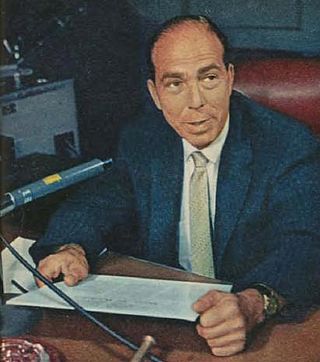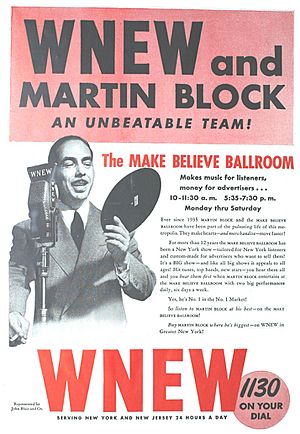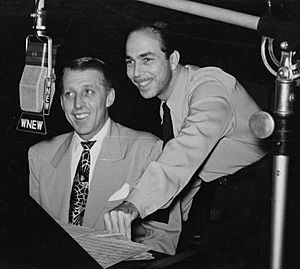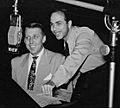Martin Block facts for kids
Quick facts for kids
Martin Block
|
|
|---|---|

Block at ABC Radio, 1957
|
|
| Born | February 3, 1903 |
| Died | September 18, 1967 (aged 64) Englewood, New Jersey
|
| Career | |
| Network | NBC ABC Mutual Broadcasting System Voice of America |
Martin Block (born February 3, 1903 – died September 18, 1967) was a famous American disc jockey. A disc jockey, or DJ, is someone who plays recorded music on the radio. It's said that a famous writer named Walter Winchell actually created the term "disc jockey" to describe Martin Block's unique radio shows.
Contents
Martin Block's Amazing Radio Career
Starting Out in Radio
Martin Block was born in Los Angeles. He started his radio career in Tijuana, Mexico. Before that, he sold small items for homes. When he was just 13, he worked as an office helper at General Electric.
When his career wasn't going well in Los Angeles, Block moved his family to New York. He quickly found a job as a radio announcer. He even created two very famous advertising slogans for his sponsors: "ABC-Always Buy Chesterfield" and "LSMFT"-Lucky Strike Means Fine Tobacco." Martin Block also loved amateur radio, which is a hobby where people use radio equipment to talk to others around the world. He had a big radio station at his home in Englewood, New Jersey.
The "Make Believe Ballroom"
In 1934, Block started working for WNEW radio station, earning $20 a week. A big moment came in 1935. People in New York were waiting for news about the famous Lindbergh kidnapping. Block used this time to play records between the news updates. This helped him gain many listeners.
This idea led to his most famous show, Make Believe Ballroom, which began on February 3, 1935. Block got the idea and the name from another DJ, Al Jarvis. On his show, Block created the feeling that he was broadcasting from a fancy ballroom. He made it sound like the country's best dance bands were playing live! He even had to buy records from a local music shop because the radio station didn't have any. His first theme song was "Sugar Blues" by Clyde McCoy.
At first, the station's sales team thought no one would want to sponsor a show that just played music. So, Block found his own sponsor: a company that made "Retardo" reducing pills. Within just one week, the company received over 3,000 responses from people who heard the ads on Block's show!
Block's Unique Style
Martin Block's way of talking on the radio was very different. Most announcers at the time spoke very loudly, as if they were talking to a huge crowd. But Block spoke in a normal voice, like he was having a friendly chat with just one listener. This made people feel like he was talking directly to them.
His influence was huge. Once, a sponsor offered a sale on refrigerators during a snowstorm in New York. Even with bad weather, 109 people came out to get the deal Block advertised! By 1941, many companies wanted to sponsor his show, and they even had to wait in line.
Helping People and World Events
In 1936, Block's "Ballroom" show accidentally helped a young man. This man was accused of a crime, but he said he was home listening to the show at the time. He remembered that Guy Lombardo, a famous bandleader, couldn't perform on the show and sent a telegram, which Block read on air. This detail proved the man's story, and he was cleared of all charges.
Two years later, world events touched the "Make Believe" world. Singer Midge Williams sang two popular American songs in Japanese. This made many listeners upset because of the recent Japanese invasion of China. NBC received many calls and messages protesting her performance.
In 1940, Make Believe Ballroom became available across the country. That same year, Block hosted a special "Jam Session" on his show. Famous musicians like the Dorsey brothers, Count Basie, and Gene Krupa played live together for half an hour. Another part of the show was called "Saturday Night in Harlem," featuring music from jazz legends like Cab Calloway and Duke Ellington. Martin Block and Make Believe Ballroom were even featured on the cover of Billboard magazine in April 1942.
During a time when musicians in the U.S. were not allowed to record new music (the 1942–44 musicians' strike), Block found a clever way to get new songs. His friends in England sent him recordings from the UK, where the ban didn't apply. This meant his show could still play fresh music with full bands.
In 1944, when the band Spike Jones and his City Slickers returned from entertaining soldiers, they couldn't find hotel rooms in New York. Spike Jones called Martin Block, who announced the problem on air. Listeners immediately called WNEW, offering places for the band members to stay!
In the 1940s, Block hired a young record collector named Joe Franklin to help him pick records. Joe Franklin later became a very famous radio and TV host in New York City for over 65 years. By 1947, Make Believe Ballroom was so popular that it aired twice a day. Block also hosted a weekly international version of the show for Voice of America starting in 1949. He even volunteered to host this show for free!
Other Radio and Music Work
Block was also the announcer for The Chesterfield Supper Club, a popular radio show. He worked on other shows like Pepper Young's Family and the CBS Hit Parade. By the end of World War II, Martin Block was earning a lot of money, about $22,000 a week! In 1946, he started hosting a music show called Columbia Record Shop for CBS.
In 1947, he signed a deal with Metro-Goldwyn-Mayer to make short musical films called Martin Block Presents. Block also appeared in a movie called Make Believe Ballroom (1949) with singers like Frankie Laine. He also had a small role in Musical Merry-Go-Round in 1948.
Block moved to Los Angeles in 1947 to do Make Believe Ballroom on the West Coast. While there, he broadcast for Mutual Broadcasting System from a studio in his home. He also continued to announce for Chesterfield Supper Club from Hollywood. After his contract ended, he returned to New York.
Back in New York, Block continued his work on the "Supper Club" and later became the announcer for its television version in 1948. In 1950, he celebrated his 15th anniversary on the radio. Variety magazine dedicated a whole section to him, with many stars he helped thanking him.
Martin Block also helped write the lyrics for the 1941 hit song "I Guess I'll Have to Dream the Rest" by Glenn Miller. He also wrote lyrics for a version of the Make Believe Ballroom theme song. Block even had his own music publishing companies. He also famously gave the singer Fannie Rose Shore her stage name, Dinah Shore, after she sang "Dinah" for him.
Later Years and Legacy
Block left Make Believe Ballroom in 1954 to host The Martin Block Show for ABC Radio. On February 3, 1955, a special show celebrated the 20th anniversary of Make Believe Ballroom. This big event, featuring many stars, was broadcast on both ABC Radio and ABC-TV. Tickets were sold to raise money for the March of Dimes.
He officially retired from ABC and radio in 1960, but he still did some work, like hosting a public affairs show for the U.S. National Guard from 1962 until his death. Martin Block passed away on September 18, 1967, in Englewood, New Jersey. He was survived by his wife, Joyce, and seven children.
After Block's death, the Make Believe Ballroom show continued for many years on WNEW, hosted by other famous DJs like William B. Williams and Steve Allen. Martin Block was honored for his contributions to radio and was inducted into the National Radio Hall of Fame in 1988.
A man named William Savory recorded many jazz radio shows, including old editions of Make Believe Ballroom. After he passed away, his son inherited the collection and sold it to the National Jazz Museum. This means many of Martin Block's classic radio shows are now preserved for future generations to enjoy!
Images for kids






